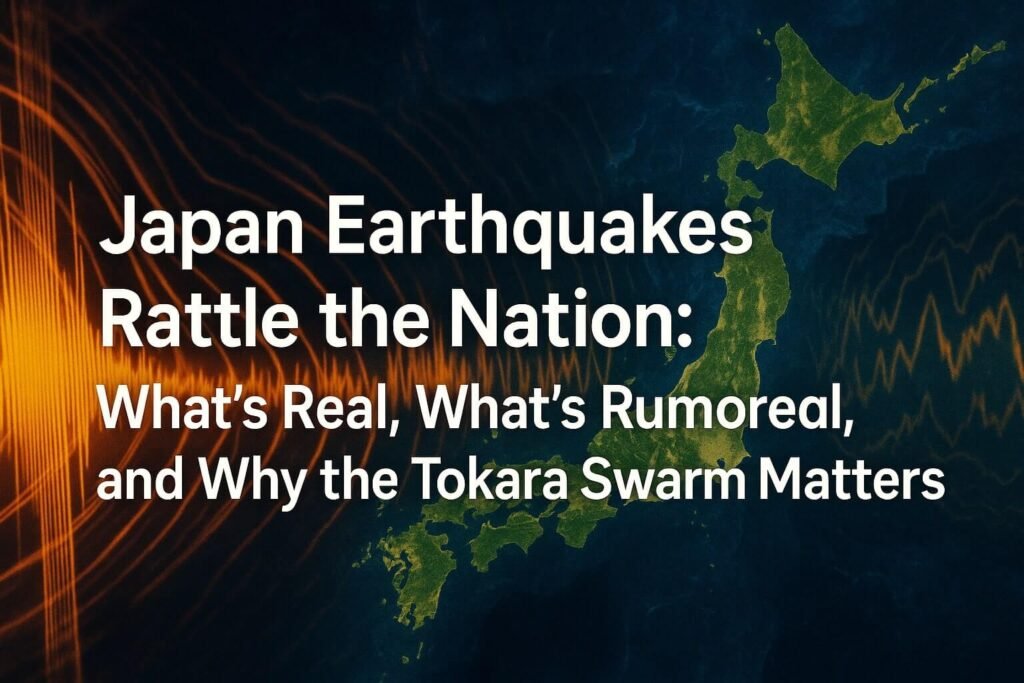Something unusual is shaking under Japan this week, and it’s not just tectonic plates. Over 1 000 small to moderate tremors have hit the remote Tokara Islands since late June, with a sharp M5.5 quake on July 3 prompting a voluntary evacuation of Akusekijima’s 76 residents. In a country already hyper-aware of seismic activity, the spike in Japan earthquakes has reignited public anxiety. A decades-old manga drawing that eerily predicts a catastrophe on July 5, 2025, is fueling online panic, flight cancellations, and last-minute travel changes across Asia.
But what’s fact, what’s fear, and what should people actually be doing now? Here’s a full breakdown, written CycloneRadar-style, blending human instinct with smart AI insights.
The Tokara Earthquake Swarm: What’s Happening Now
The Tokara Islands sit between Kyushu and Okinawa, perched along one of the world’s most active fault systems. Since June 21, more than a thousand tremors have shaken the archipelago, with most being mild but a few strong enough to cause real alarm. The biggest so far, a magnitude 5.5 quake at 4:13 p.m. on July 3, struck just 10 km deep near Akusekijima and registered a strong lower 6 on the shindo scale. That’s enough to rattle shelves, crack walls, and make residents reconsider their week.
While no injuries or major damage were reported, village officials quickly stepped up. Residents were offered a voluntary evacuation via ferry to Kagoshima City, where a gymnasium now doubles as a shelter. The move is less about imminent danger and more about being cautious in the face of uncertainty.
Seismologists say the quake swarm is most likely tied to shallow crustal movement, not volcanic activity. The quakes are occurring around 10 to 30 km deep, too shallow to be tectonic megathrusts but still capable of fierce localized shaking.
The “Prophecy” That Made Everything Worse
As if the earth wasn’t noisy enough, social media added fuel to the fire. A manga comic book titled The Future I Saw resurfaced, with a panel showing a tsunami disaster dated July 5, 2025. The manga’s artist previously predicted the 2011 Tohoku disaster, lending eerie weight to the prophecy. Fear spread fast. Travel bookings dropped across Hong Kong and the Greater Bay Area, with some airlines slashing routes to Japan and offering summer flight discounts to ease the cancellations.
Despite the buzz, scientists at the Japan Meteorological Agency (JMA) and international earthquake centers have spoken out clearly. Earthquakes can’t be predicted to the day, and this so-called prophecy is a coincidence, not a forecast. Seismologist Ryoichi Nomura likened quake prediction to guessing the exact second a popcorn kernel pops. You can guess a window, but not the tick of the clock.
Still, authorities don’t entirely hate the public’s sudden attention. If this renewed fear gets people to check their go-bags, secure their furniture, and download the latest early warning apps, that’s a net win for disaster readiness.
Why Japan Earthquakes Are Frequent, and Why They Matter
Japan sits at the meeting point of four tectonic plates: the Pacific, Philippine Sea, Eurasian, and North American. The Tokara swarm is part of the boundary where the Philippine Sea plate dives under the Eurasian plate. It’s a hotbed of seismic stress, and these kinds of swarms happen when accumulated strain releases across a cluster of faults.
Quakes like these don’t necessarily predict a megaquake, but they do show how stress moves and redistributes underground. And with long-standing warnings of a possible Nankai Trough quake in the next 30 years, every new swarm is treated as data gold for researchers and a wake-up call for emergency managers.
The government estimates an 80 percent chance of an M8-class quake off southern Honshu in the coming decades. That scenario could create tsunami waves up to 30 meters high. It’s one reason why preparedness drills are part of daily life in many coastal communities.
Japan is arguably the most earthquake-ready country on Earth. From early-warning alerts that buzz phones seconds before tremors arrive to structural codes designed for shaking, the system is built to save lives. But that doesn’t mean complacency is an option.
Real-Life Impacts Now: What We’re Seeing
So far, the Tokara swarm has caused mostly logistical disruption. No fatalities, no building collapses. But it’s not business as usual either. Ferry routes are altered, schools are paused, and Kagoshima’s emergency shelters are up and running.
Tourism is taking a visible hit. Hong Kong’s arrivals to Japan fell over 10 percent in June. Greater Bay Airlines cancelled some July and August flights outright. Packages to Tokyo and Osaka have dropped in price as agencies try to soothe skittish travelers. Even those not swayed by manga prophecies are now watching seismic updates with refreshed interest.
Elsewhere in Japan, smaller quakes continue near Miyagi Prefecture and off Hokkaido. A few moderate jolts have hit the Izu-Bonin arc and the Noto Peninsula. It’s all part of the usual rhythm in a country that never really sits still.
How to Stay Ready Without Panic
Even without a prediction or a named earthquake looming, there are smart things residents and travelers should do now.
- Download official apps like Yurekuru Call and NHK News & Disaster Info to get real-time alerts.
- Check evacuation maps, especially in coastal towns. Know where to go if a tsunami warning sounds.
- Secure your home by strapping down heavy furniture and checking gas and water shutoffs.
- Avoid the rumors. Earthquakes don’t come with an RSVP. Follow verified sources like JMA or USGS.
Japan earthquakes are inevitable, but large-scale disasters don’t have to be. Preparedness and smart communication make the difference. Even if this week’s tremors fade quietly, the conversation they’ve sparked may lead to better public understanding and stronger personal safety habits.
Whether you live in Tokyo, visit Okinawa, or keep an eye on global seismic trends, one thing’s clear: Japan’s earthquakes are a constant, but your response can be calm, informed, and ready.


